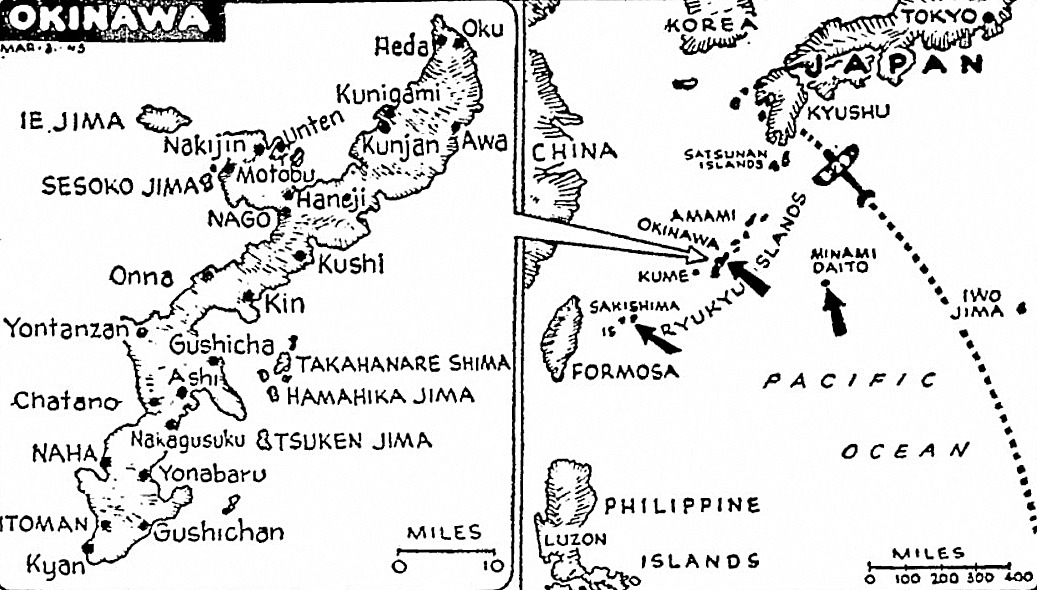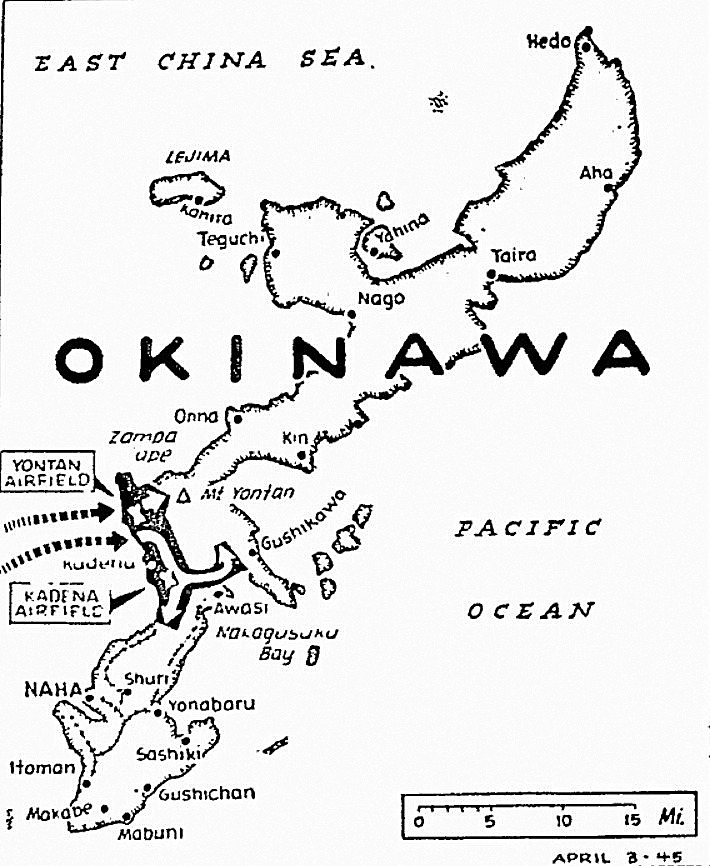The Pittsburgh Press (April 1, 1945)
JAPS REEL UNDER FLEET ATTACKS
Navy planes blast 47 ships off Okinawa
Invasion armada on way, Tokyo says
Devastating task force attacks on Okinawa Island continued Saturday for the ninth day, Adm. Nimitz announced. Minami Daito Island, 300 miles east of Okinawa, and the Sakishima Islands were also attacked by the task forces. Units of the British Fleet made the Sakishima attack. Superfortresses blasted targets on Kyushu, Jap home island, in what Tokyo said was part of the preparations for an early invasion of Okinawa.
GUAM (UP) – U.S. carrier-based planes have destroyed or damaged 49 Jap ships in almost continuous attacks on the Ryukyu Islands, it was announced today.
Radio Tokyo reported that a huge, heavily guarded transport armada was bearing down on Okinawa, chief island of the Ryukyus, 330 miles south of Japan, led by minesweepers.
More than 100 Superfortresses from the Marianas blasted targets on the southern Jap island of Kyushu. Big guns of Adm. Raymond A. Spruance’s U.S. Fifth Fleet hammered Okinawa with thousands of shells Saturday for the ninth successive day. The British Pacific Fleet again battered the Sakishima Islands between Formosa and Okinawa.
Naval power massed
The Japs were reeling under some of the heaviest blows of the Pacific war.
Radio Tokyo said “one-fourth to one-third” of all of America’s naval power now was concentrated in the Far Western Pacific on Japan’s doorstep intensifying attacks which have cost the Japs 967 planes and 104 to 108 ships destroyed or damaged in two weeks.
Dispatches from the U.S. Fleet flagship said Okinawa was a scene of “utter desolation.” A thick black cloud of smoke covered the island. Pilots saw no human activity and concluded that the Japs had taken to the rugged northern hills to escape the hellish bombardment.
Nimitz gives score
Adm. Chester W. Nimitz announced that fast carrier task forces battered Kyushu and the Ryukyu Islands Wednesday and Thursday.
They ran up the following score:
- SUNK: Two destroyer escorts, one medium cargo ship, ten small cargo ships, four luggers, one motor torpedo boat – Total 18.
- PROBABLY SUNK: Nine medium cargo ships, five small cargo ships – Total 14.
- DAMAGED: One destroyer escort, 13 small cargo ships, one medium cargo ship – Total 15.
In addition, carrier planes attacking Okinawa Friday, destroyed four submarine pens and two torpedo boats in the submarine base at Unten Bay on the west coast.
29 planes bagged
The carrier planes, in the Wednesday-Thursday attacks, shot down 29 Jap planes and one glider in air battles, destroyed 16 planes on the ground and damaged or destroyed 42 others aground.
In addition, they damaged airplane hangars, shops and other installations on Tokuno Island, 70 miles northeast of Okinawa, on Yaku Island, 49 miles south of Kyushu, and in the southern Kyushu cities of Kanoya, Kushira. Chiran, Tojimbara and Ibusuki. U.S. losses were 12 planes and six pilots.
Ninth day of attacks
Fleet battleships, including new 45,000 tonners, Friday steamed up to Okinawa and shelled shore installations at close range. They breached sea walls and hammered gun positions, airfields and bridges.
Adm. Nimitz said the Okinawa attacks by both planes and surface ships continued through Saturday, the ninth successive day of a terrific bombardment similar to those which preceded the invasions of other Pacific islands, only more intense.
Tokyo radio said the gigantic fleet had been reinforced and warships alone numbered 150, including 17 battleships. The enemy said part of the fleet: had approached Kume Island, 50 miles west of Okinawa.
Decisive battle predicted
The enemy said the start of landings on Okinawa could be only a matter of time and the radio quoted one Jap newspaper that “the time for the decisive battle between Japan and America finally has come upon us.”
The London radio said U.S. planes had laid mines in Japan’s Inland Sea and off Southern Kyushu.
Tokyo said U.S. minesweepers were preparing for landing operations off Okinawa and were followed by a powerful transport armada. It said “thousands upon thousands of shells are landing on Okinawa.”
Adm. Nimitz announced that surface forces had attacked barracks, warehouses, the radio station, ammunition dumps and the airdrome on Minami Daito, 200 miles east of Okinawa and 635 miles west of Iwo.
British hit Sakishimas
The British Fleet yesterday struck the Sakishimas, which it also had hit last Monday and Tuesday, Adm. Nimitz said. Army Liberator bombers attacked the Jap naval base at Kataoka on Shumushu in the Northern Kuril Islands.
Headquarters of the XXI Bomber Command announced that Superfortresses had battered Kyushu again yesterday for the second time in five days. Tokyo radio said the raid lasted for two hours and that principal targets were airfield installations.
It was revealed that in the previous Superfortress attack on Kyushu 56 Jap planes were destroyed or damaged, and heavy damage was inflicted on the great Omura aircraft factory as well as on two Kyushu airfields.


